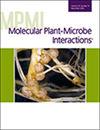Jana Sperschneider, Jian Chen, Claire Anderson, Emmanuelle Morin, Xiaoxiao Zhang, David Lewis, Eva Henningsen, Igor V Grigoriev, John P Rathjen, David A Jones, Sebastien Duplessis, Peter N Dodds
求助PDF
{"title":"A Chromosome-Scale Genome Assembly of the Flax Rust Fungus Reveals the Two Unusually Large Effector Proteins, AvrM3 and AvrN.","authors":"Jana Sperschneider, Jian Chen, Claire Anderson, Emmanuelle Morin, Xiaoxiao Zhang, David Lewis, Eva Henningsen, Igor V Grigoriev, John P Rathjen, David A Jones, Sebastien Duplessis, Peter N Dodds","doi":"10.1094/MPMI-04-25-0047-R","DOIUrl":null,"url":null,"abstract":"<p><p>Rust fungi comprise thousands of species, many of which cause disease on important crop plants. The flax rust fungus <i>Melampsora lini</i> has been a model species for the genetic dissection of plant immunity since the 1940s; however, the highly fragmented and incomplete reference genome has so far hindered progress in effector gene discovery. Here, we generated a fully phased, chromosome-scale assembly of the two nuclear genomes of <i>M. lini</i> strain CH5, resolving an additional 320 Mbp of the sequence. The 482-Mbp dikaryotic genome is at least 79% repetitive, with a large proportion (approximately 40%) of the genome comprising young, highly similar transposable elements. The assembly resolves the known effector gene loci, some of which carry complex duplications that were collapsed in the previous assembly. Using a genetic map followed by manual correction of gene models, we identified the <i>AvrM3</i> and <i>AvrN</i> genes, which encode unusually large fungal effector proteins and trigger defense responses when co-expressed with the corresponding resistance genes. We located the genes linked to the tetrapolar mating system on chromosomes 4 and 9, but in contrast to the cereal rusts that have one pheromone receptor gene per haplotype, in flax rust, three pheromone receptor genes were found, with two of them closely linked on one haplotype. Taken together, we show that a high-quality assembly is crucial for resolving complex gene loci, and given the increasing number of fungal effectors of large size, the commonly applied criterion for effector candidates of being small proteins needs to be reconsidered. [Formula: see text] Copyright © 2025 The Author(s). This is an open access article distributed under the CC BY-NC-ND 4.0 International license.</p>","PeriodicalId":19009,"journal":{"name":"Molecular Plant-microbe Interactions","volume":" ","pages":"MPMI04250047R"},"PeriodicalIF":3.4000,"publicationDate":"2025-10-14","publicationTypes":"Journal Article","fieldsOfStudy":null,"isOpenAccess":false,"openAccessPdf":"","citationCount":"0","resultStr":null,"platform":"Semanticscholar","paperid":null,"PeriodicalName":"Molecular Plant-microbe Interactions","FirstCategoryId":"99","ListUrlMain":"https://doi.org/10.1094/MPMI-04-25-0047-R","RegionNum":3,"RegionCategory":"生物学","ArticlePicture":[],"TitleCN":null,"AbstractTextCN":null,"PMCID":null,"EPubDate":"","PubModel":"","JCR":"Q2","JCRName":"BIOCHEMISTRY & MOLECULAR BIOLOGY","Score":null,"Total":0}
引用次数: 0
引用
批量引用
Abstract
Rust fungi comprise thousands of species, many of which cause disease on important crop plants. The flax rust fungus Melampsora lini has been a model species for the genetic dissection of plant immunity since the 1940s; however, the highly fragmented and incomplete reference genome has so far hindered progress in effector gene discovery. Here, we generated a fully phased, chromosome-scale assembly of the two nuclear genomes of M. lini strain CH5, resolving an additional 320 Mbp of the sequence. The 482-Mbp dikaryotic genome is at least 79% repetitive, with a large proportion (approximately 40%) of the genome comprising young, highly similar transposable elements. The assembly resolves the known effector gene loci, some of which carry complex duplications that were collapsed in the previous assembly. Using a genetic map followed by manual correction of gene models, we identified the AvrM3 and AvrN genes, which encode unusually large fungal effector proteins and trigger defense responses when co-expressed with the corresponding resistance genes. We located the genes linked to the tetrapolar mating system on chromosomes 4 and 9, but in contrast to the cereal rusts that have one pheromone receptor gene per haplotype, in flax rust, three pheromone receptor genes were found, with two of them closely linked on one haplotype. Taken together, we show that a high-quality assembly is crucial for resolving complex gene loci, and given the increasing number of fungal effectors of large size, the commonly applied criterion for effector candidates of being small proteins needs to be reconsidered. [Formula: see text] Copyright © 2025 The Author(s). This is an open access article distributed under the CC BY-NC-ND 4.0 International license.
亚麻锈菌的染色体基因组组装揭示了两个异常大的效应蛋白,AvrM3和AvrN。
锈菌包括数千种,其中许多会对重要的农作物造成疾病。自20世纪40年代以来,亚麻锈菌Melampsora lini一直是植物免疫遗传解剖的模式物种,但高度碎片化和不完整的参考基因组迄今阻碍了效应基因的发现。在这里,我们生成了M. lini菌株CH5的两个核基因组的全阶段染色体尺度组装,解析了额外的320 Mbp序列。482mbp的双核基因组至少79%是重复的,其中大部分(~40%)的基因组由年轻的、高度相似的转座元件组成。该组装分解了已知的效应基因位点,其中一些基因位点携带在先前组装中崩溃的复杂复制。利用遗传图谱和人工校正基因模型,我们确定了AvrM3和AvrN基因,它们编码异常大的真菌效应蛋白,并在与相应的抗性基因共表达时触发防御反应。我们在4号和9号染色体上找到了与四极交配系统相关的基因,但与每单倍型有一个信息素受体基因的谷物锈病不同,在亚麻锈病中发现了三个信息素受体基因,其中两个基因在一个单倍型上紧密相连。综上所述,我们表明高质量的组装对于解决复杂的基因位点至关重要,并且考虑到越来越多的大尺寸真菌效应物,通常应用的效应物候选标准是小蛋白质需要重新考虑。
本文章由计算机程序翻译,如有差异,请以英文原文为准。

 求助内容:
求助内容: 应助结果提醒方式:
应助结果提醒方式:


